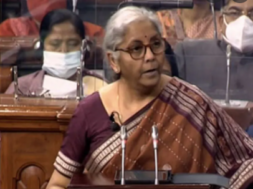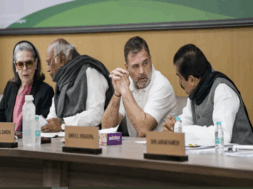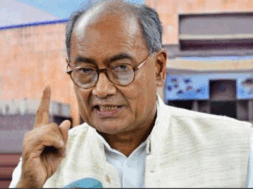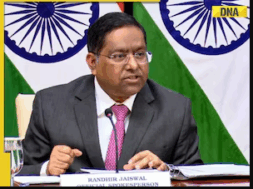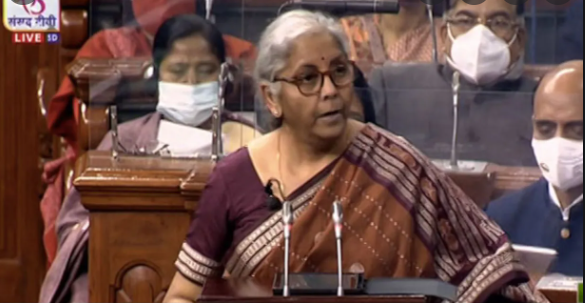
Union Budget FY23: Short on words, long on results as Indian economy regains pace
Virendra Pandit
New Delhi: Finance Minister Nirmala Sitharaman’s fourth consecutive Union Budget 2022-23, presented in the Lok Sabha on Tuesday, was the shortest at just a 90-minute-long speech, but its impact will be felt in the longer term. Its focus was to keep gains and speed up the pace of the recovery of the Indian economy post-pandemic, create millions of jobs in infrastructure, boost the MSME sector, and spur exports growth, particularly in the defense sector.
The next financial year’s expansionary, growth-oriented Budget seeks to increase the government’s capital expenditure by 35.4 percent to Rs.7.5 lakh crore as against the Budget estimate of Rs. 5.54 lakh crore in 2021-22. They estimated the effective capital expenditure in FY23 at Rs.10.5 lakh crore.
In another key move, even in the current fiscal, the government’s Capex spend has been revised to over Rs. 6 lakh crore.
The FM also highlighted that the government is keen to nurture growth in the economy through public investments and help “crowd in” private investments, which are showing signs of a pickup in the current year.
Sitharaman focused on boosting economic growth over fiscal prudence and overshot the fiscal deficit at the revised level in 2021-22 to 6.9 percent, as against the previously budgeted 6.8 percent. For FY23, they have pegged the fiscal deficit target at 6.4 percent. She noted she was aware of the medium-term fiscal deficit target of 4.5 percent for 2025-26, announced in the last year’s Budget.
This stance on fiscal deficit and promised an increase in Capex cheered the capital markets, with the benchmark indices shooting up by 878 points (Sensex) and 237 points (Nifty) until the disinvestment numbers unfolded
On disinvestment receipts, which worried the market observers, the Centre has scaled down the revised estimates to Rs. 78,000 crore for the current fiscal as against Rs. 1.75 lakh crore at the Budget estimate level.
The Budget announcement came in the backdrop of the third pandemic wave’s impact amid rising inflation and increased unemployment and ahead of Assembly elections in five states, including Uttar Pradesh and Punjab, starting this month.
In 2022-23, the government will go in for borrowing of Rs. 14.95 lakh crore, up from Rs. 12 lakh crore estimated for 2021-22.
To help the MSMEs, the backbone of the Indian economy, and to cope with pandemic losses, the FM announced the extension of the Emergency Credit Line Guarantee Scheme (ECLGS) by one year until March 31, 2023. The guarantee cover has also been expanded by Rs. 50,000 crores to take the overall cover under the scheme to Rs. 5 lakh crore.
Sitharaman announced that the Credit Guarantee Trust for Micro and Small Enterprises (CGTMSE) will be revamped with a required infusion of funds.
Besides the continuation of its policy to encourage public investments, the Budget has kept the tax slabs unchanged. The slew of measures announced in the latest Budget includes steps to encourage the start-ups’ ecosystem, usage of electric vehicles, and 5G spectrum auction in 2022-23.
On digital currency and virtual assets, the FM announced that the Reserve Bank of India (RBI) will this year issue a “digital rupee” as the Central Bank Digital Currency (CBDC). She also unveiled a specific taxation regime for transferring any virtual asset at 30 percent.
To spur exports, she said that a new Special Economic Zone (SEZ) law will be enacted and customs administration of such zones will be improved through technology and IT adoption.
The government will undertake ‘Ease of Doing Biz 2.0’ and take steps to speed up the pace of exits for businesses, Sitharaman said.
Also, the Insolvency and Bankruptcy Code (IBC) will be amended to enhance the efficiency of resolutions, and a comprehensive framework for cross-border insolvency will be introduced.
The Budget laid the blueprint from India@75 to India@100 to mark the Indian economy’s transition from the one at its 75 years of Independence in 2024 to 100 years in 2047.
Other key highlights of the Budget
- Total expenditure in 2022-23 estimated at Rs 39.45 lakh crore. Total receipts other than borrowings in 2022-23 estimated at Rs 22.84 trillion.
- Fiscal deficit in 2021-22 estimated to rise to 6.9 percent of GDP against 6.8 percent in Budget Estimates. For FY23, it is pegged at 6.4 percent of GDP. A target set to reduce it to 4.5 percent of GDP by 2025-26.
- The Budget allows taxpayers to file updated income tax returns within 2 years for correcting errors. It also provides tax relief to persons with disability. Payment of annuity and lump sum amount from insurance scheme to be allowed to differently-abled people’s dependents during the lifetime of parents/guardians, i.e., on parents/ guardian attaining the age of 60 years.
- Parity in National Pension Scheme Contribution: Tax deduction limit increased from 10 percent to 14 percent on an employer’s contribution to the NPS account of the State Government employees.
- Customs duty on cut and polished diamonds and gemstones being reduced to 5 percent; No customs duty to simply sawn diamond will give a boost to the gems and jewelry sector. A simplified regulatory framework is to be implemented by June this year to facilitate the export of jewelry through e-commerce.
- Unblended fuel to attract an additional differential excise duty of Rs 2/liter from October 1, 2022, to encourage the blending of fuel.
- A Digital University will be established to provide access to students across the country to world-class quality universal education with a personalized learning experience at their doorsteps. This will be made available in different Indian languages and ICT formats.
- Productivity Linked Incentive (PLI) scheme in 14 sectors to create 60 lakh jobs. PLI schemes have the potential to create an additional production of Rs 30 lakh crore.
- Entering Amrit Kaal, the 25-year-long period to lead India @100, the Budget provides the impetus for growth along with four priorities: PM GatiShakti, Inclusive Development, Productivity Enhancement & Investment, Sunrise opportunities, Energy Transition, and Climate Action and Financing of investments.
- The seven engines that drive the PM GatiShakti are roads, railways, airports, ports, mass transport, waterways, and logistics infrastructure. The PM GatiShakti National Master Plan will encompass the seven engines for economic transformation, seamless multimodal connectivity, and logistics efficiency. The National Highways Network to be expanded by 25,000 km in 2022-23. Rs 20000 crore to be mobilized for National Highways Network expansion in 2022-23. Contracts to be awarded through PPP mode in 2022-23 for implementation of Multimodal Logistics Parks at four locations.
- Railways:2,000 km of the railway network to be brought under Kavach, the indigenous world-class technology, and capacity augmentation in 2022-23. 400 new generation Vande Bharat Trains to be manufactured during the next three years. 100 PM GatiShakti Cargo terminals for multimodal logistics to be developed during the next three years.
- One Station One Product concept to help local businesses and supply chains.
- Agriculture: Rs 2.37 lakh crores direct payment to 1.63 crore farmers for procurement of wheat and paddy. Chemical-free natural farming is to be promoted throughout the county. The initial focus is on farmer’s lands in 5 km wide corridors along River Ganga.
- NABARD to facilitate funds with blended capital to finance startups for agriculture and rural enterprise. ‘Kisan Drones’ for crop assessment, digitization of land records, spraying of insecticides and nutrients.
- MSMEs: Udyam, e-shram, NCS, and ASEEM portals to be interlinked. 1.30 crore MSMEs provided additional ECLGS, which will be extended up to March 2023. Guarantee cover under ECLGS to be expanded by Rs 50,000 crore to a total cover of Rs 5 Lakh crore.
- Rs 2 lakh crore additional credit for MSMEs to be facilitated under the CGTMSE. Raising and speeding up MSME performance (RAMP) program with an outlay of Rs 6,000 crore to be rolled out.
- 60,000 crore allocated to cover 3.8 crore households in 2022-23 under Har Ghar, Nal se Jal.
- Housing for all: Rs 48,000 crore allocated for completion of 80 lakh houses in 2022-23 under PM Awas Yojana.
- New scheme PM-DevINE launched to fund infrastructure and social development projects in the North-East. An initial allocation of Rs 1,500 crore was made to enable livelihood activities for youth and women under the scheme.
- All the 1.5 lakh post offices to come on the core banking system. Scheduled Commercial Banks to set up 75 Digital Banking Units (DBUs) in 75 districts.
- e-Passports with embedded chip and futuristic technology to be rolled out.
- Scheme for design-led manufacturing to be launched to build a strong ecosystem for 5G as part of the Production Linked Incentive Scheme.
- Defence:68 percent of capital procurement budget earmarked for the domestic industry in 2022-23, up from 58 percent in 2021-22. Defense R & D to be opened up for industry, start-ups, and academia, with 25% of defense R & D budget earmarked.
- Additional allocation of Rs. 19,500 crore for Production Linked Incentive for the manufacture of high-efficiency solar modules to meet the goal of 280 GW of installed solar power by 2030.
